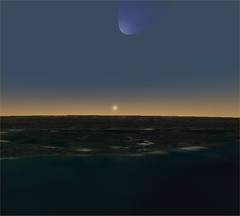 As I mentioned a few weeks back, I did a second podcast for 365daysofastronomy.org, and it's available today. It's called "JPL's Greatest Hits" and in it, I talk about what I consider to be the "top 10" space exploration missions that have come out of the amazing Jet Propulsion Laboratory since 1958. It's a pretty subjective list, of course, since JPL has done so many great missions and continues to do so today. But it's fun and I hope also informative.
As I mentioned a few weeks back, I did a second podcast for 365daysofastronomy.org, and it's available today. It's called "JPL's Greatest Hits" and in it, I talk about what I consider to be the "top 10" space exploration missions that have come out of the amazing Jet Propulsion Laboratory since 1958. It's a pretty subjective list, of course, since JPL has done so many great missions and continues to do so today. But it's fun and I hope also informative.I had planned to do a few supplementary posts for this podcast, but I got distracted by other things the last few weeks, and I forgot! I will probably add a few posts on specific JPL missions in the next few days, and I have also started a new set on my Flickr site to post some images.
Of course you can get plenty of information and images from JPL's own web site, including this summary page listing all JPL missions. But what you can't get from JPL is a way to "fly" those missions yourself using the free Orbiter space flight simulator, which is something I mention only briefly in the podcast itself. Add-on makers have created amazing simulations of many of JPL's spacecraft, including 9 of my top 10. Some of these include extensive documentation and will allow you to simulate the missions from launch to orbital insertion or landing. Many include deployable or operable parts, so you can really learn a lot about these missions by playing with these simulations.
I have tried nearly all of these add-ons in Orbiter at one time or another, but not all of them recently, so I can't guarantee that some of the older ones will work right out of the box with the current version of Orbiter. Check with the Orbiter Forum if you have trouble, or post a comment here. I won't use the DJ-like backwards countdown for this list. All of these free Orbiter add-ons and many, many more are available at Orbit Hangar. John Graves is clearly a champion of planetary exploration simulations for Orbiter!
- Mars Rovers, add-on by Scott Conklin ("Usonian") - Amazingly complete and detailed! See picture above.
- Voyager ver. 1.3 by John Graves ("missleman01")
- Viking Mars mission by John Graves
- Mariner 10 by John Graves (my #4 is the whole Mariner series in my top-10, but only Mariner 10 is available for Orbiter)
- Cassini-Huygens Saturn mission by John Graves
- Galileo Jupiter by John Graves
- Mars Global Surveyor is not available, but Brian Jones' MRO add-on is great!
- Surveyor moon landers by Jim Williams
- Magellan Venus by John Graves
- Explorer 1 by Jim Williams (there is a newer version by "Bigmac" that I have not tried)
More to come in the next few days - please check back, and also let me know if you have any questions or special topics you would like me to discuss.


























